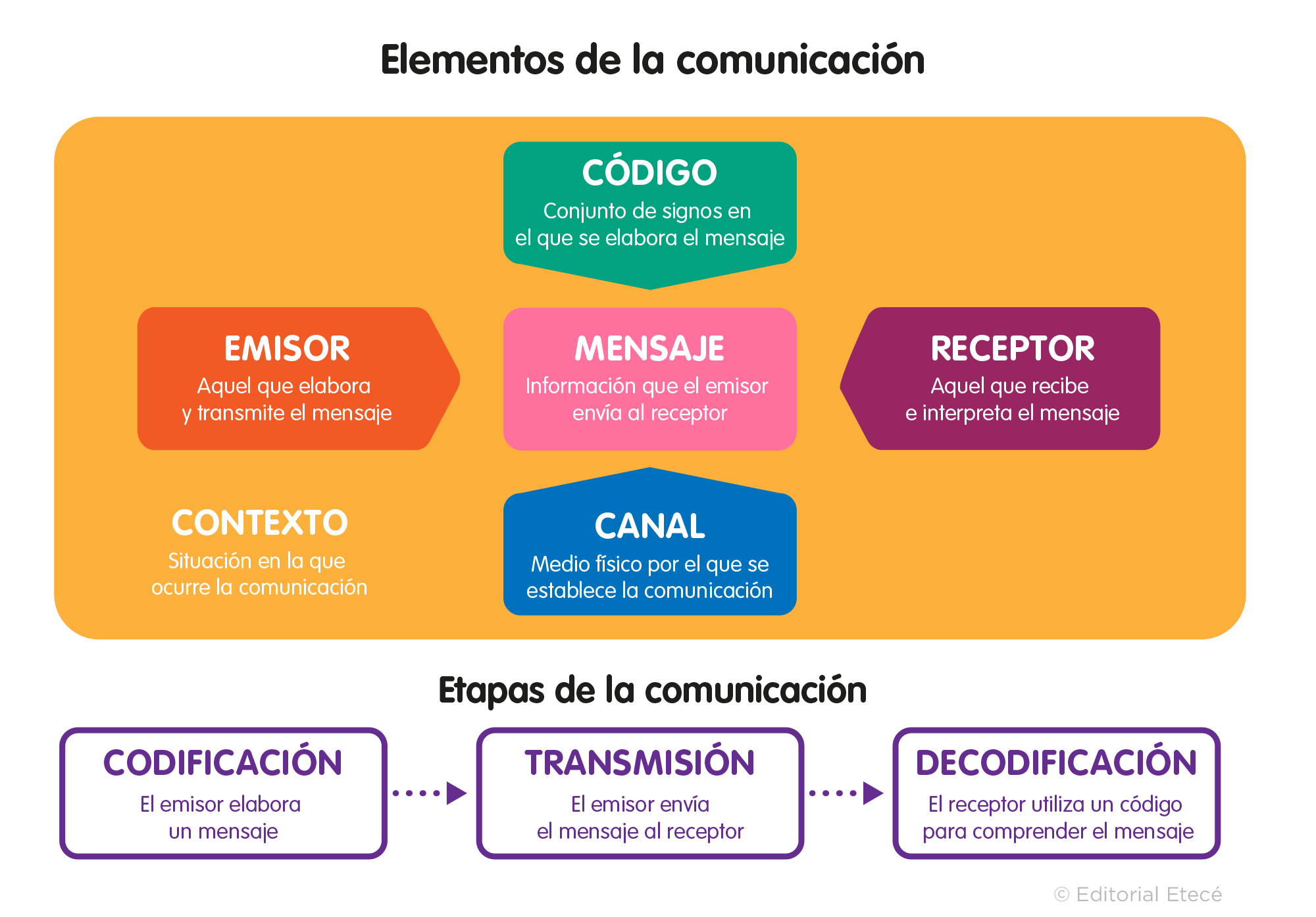We explain what the elements of communication are and what their components are. Also, examples of each.

What are the elements of communication?
The elements of communication are sender, receiver, message, code, channel and context. These components are present in all communicative events.
Communication consists of the transmission of information between two or more individuals. It can be verbal, when it occurs through words, or non-verbal, when it occurs through gestures, movements or non-linguistic sounds. For example, a telephone call, a discussion, a letter or a conference.
Beyond the differences that may exist between communicative events, the same elements participate in all of them. Each one of them plays a determining role and has a specific function.

1. Issuer
The sender is the one who generates a message and transmits it. Their role is to initiate the communicative event. It can be a person, an animal, a group, a company, an institution, among others. For example:
- A teacher explaining a topic in class.
- A young man sending a cell phone message to a friend.
What to communicate and what is the best way to do it, that is, with what elements the message is produced, are questions that are generally decided by the sender.
See also: Issuer
2. Receiver
The receiver is the one who receives the message and then decodes it to be able to interpret the information. To do this, you must know and understand the code or language with which the sender constructs and transmits the message. For example:
- The students listening to their teacher's explanation.
- The friend who receives a message on his phone.
In some cases, the receiver decodes the message and is then able to create a response for the sender himself. For example, a student answering a question from the teacher.
Feedback: It is a phenomenon that occurs when the receiver assumes the role of sender and creates a new message in response to the previous one, so that the communicative action restarts with the roles reversed. Feedback is frequent in many communication processes, but not strictly necessary. For example, it usually occurs in face-to-face conversations, but not when reading a book.
See also: Receiver
3. Message
The message is the information that the sender transmits to the receiver. Messages are usually made with the signs of a certain code, for example, the words of a language.
A message can be verbal (if it is produced with words) or non-verbal (if it is produced with elements that are not words, such as images or gestures), and can be spoken, written, auditory, visual, among others. For example:
- The words that the teacher uses to explain multiplications, that is, the topic of the class.
- The written message with which a young man invites his friend to the cinema.
See also: Message
4. Code
The code is the system of signs that the sender uses to produce their message and the receiver uses to understand it.. To ensure good communication, participants must share the same code, since they must know the meaning of their signs. For example:
- The oral Spanish language that the teacher uses to teach the class.
- The written Spanish language and the emoticons that the young man uses when he writes to his friend.
The code of a communicative event can be:
- Linguistic or verbal code. It is a language and can be both written and oral. For example: the French language or the Chinese language.
- Non-linguistic or non-verbal code. It is not a language or a language, but a set of signs that are not words. It can be auditory, gestural or visual. For example: a traffic signal or the siren of an ambulance.
See also: Code
5. Channel
The channel is the medium or medium through which the message is transmitted.. It is always a physical medium and can be of different types, such as paper, the Internet, the air, radio or television. For example:
- The air through which the teacher's voice reaches the students.
- Cell phones connected to the Internet that allow the young man and his friend to communicate.
Noise: It is an event that affects the channel or code, because it does not allow the message to be transmitted or decoded effectively. It can be technical (for example, when a message cannot be heard well because there is interference in the telephone signal) or semantic (for example, when a person does not understand the meaning of a word). Although noise affects the communication process, it does not completely interrupt it.
See also: Channel
6. Context
The context is the environment in which communication takes place. It is formed by a sum of both physical and non-physical conditions. It may include characteristics such as space, time, social, historical and political context, the type of link between sender and receiver, among others. For example:
- The mathematics class that takes place within the classroom.
- The bus where the young man is at the time of sending the message.
The context always influences the message, because it determines how it is produced and how its meaning is interpreted. For example, if a person has to complete a procedure at an embassy, they will use formal language in the message, because the context demands it.
Concerning: Some linguists consider that there is another element of communication called concerningthat is, the topic discussed in the message. For example, in a mathematics class, the referent may be multiplication.
See also: Context
Communication process
The communication process is any exchange of information that occurs between two living beings. For example, when two people are talking or when one dog barks at another.
This process is made up of all the elements of communication and, for it to occur, requires three stages:
- Coding. The sender produces a message in which he expresses his ideas through the signs of a code.
- Transmission. The message leaves the sender and reaches the receiver in a specific context. This process always depends on there being a channel through which the message can travel.
- Decoding. The receiver interprets and understands the message. To do this, you must know the code with which it was created.
See also: Communication process
Example of elements in the communication process
The elements of a communicative process can be:
- Transmitter. One person writes a letter in a specific code, the Spanish language, and sends it to another.
- Receiver. A person receives the letter, reads it and interprets its meaning.
- Message. The information contained in the letter.
- Code. The written Spanish language.
- Channel. The paper on which the letter is written.
- Context. A person who lives in Lima writes a letter to another, who lives in Santiago de Chile.
In this case, the feedback could occur if the recipient responded to the letter. Furthermore, there could be noise if the paper of the letter was torn or the ink smudged, so that the recipient could not read the message properly.
document.addEventListener(“DOMContentLoaded”, (e) => {
var sliderContainer, slider;
sliderContainer = document.getElementById(‘block_a6cf94c6124fc36044d93109d02aaa8a’);
if (typeof initSlider !== ‘function’) {
console.log(‘Swiper haven\’t been loaded’);
sliderContainer.className += ‘ fw scroll-snap’;
return;
};
options = {
direction: ‘horizontal’,
speed: 1000,
slidesPerView: ‘auto’,
// slidesPerGroup: 1,
centerInsufficientSlides: true,
// centeredSlides:true,
spaceBetween: 15,
breakpoints: {
720: {
// centeredSlides: false,
// slidesPerGroup: 2,
spaceBetween: 25
},
},
pagination: {
el: ‘.swiper-pagination’,
type: ‘bullets’,
clickable: true
},
}
slider = initSlider(sliderContainer, options);
})
References
- Escandell Vidal, MV (2020). Communication. Language, cognition and society. Akal.
- Gavidia Anticona, J. A. (2015). Language and communication. Editions of the U.
- Gómez, FSJ (2016). Communication. Salus, 20(3), 5-6. http://ve.scielo.org
- Jakobson, R. (1974). General linguistics essays. Six Barral.





